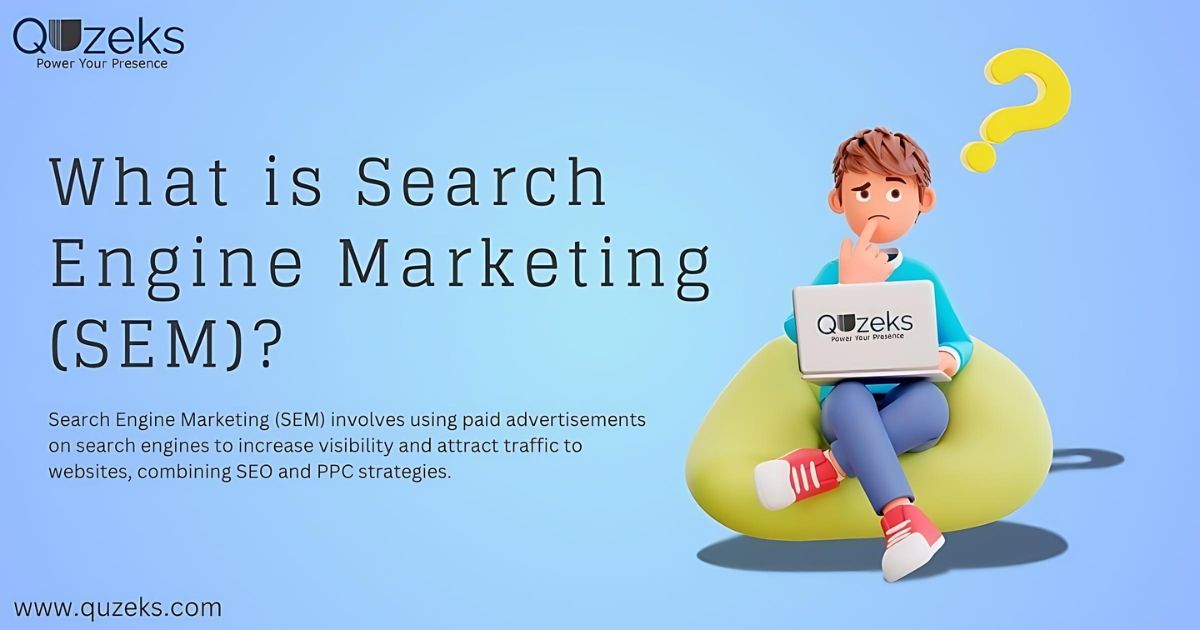- Search Engine Marketing (SEM) is a cornerstone of digital marketing that offers numerous advantages for businesses aiming to enhance their online presence, attract potential customers, and drive growth.
- This blog will provide a comprehensive introduction to SEM, explaining what it is, how it works, its importance, its role in digital marketing, and how to create an effective SEM campaign strategy.
What is Search Engine Marketing?
- Search Engine Marketing (SEM) is a form of digital marketing that involves promoting websites by increasing their visibility in search engine results pages (SERPs) through paid advertising.
- Unlike Search Engine Optimization (SEO), which focuses on improving organic search rankings, SEM leverages paid search ads to target specific keywords and attract potential customers.
How SEM Works
SEM operates primarily through pay-per-click (PPC) advertising. Here’s a breakdown of how it works:
Keyword Research: The process starts with identifying relevant keywords that potential customers are likely to use when searching for products or services. Tools like Google Keyword Planner help in finding high-value keywords.
Creating Ads: Advertisers create text-based ads that will appear in search results. These ads are crafted to be compelling and include a call to action to entice users to click.
Bidding on Keywords: Advertisers bid on the selected keywords. The bid amount represents how much they are willing to pay for each click on their ad. Higher bids can lead to better ad placement.
Ad Auction: When a user conducts a search, an ad auction takes place. The search engine evaluates the bids and the quality of the ads to determine which ads will appear and in what order.
Ad Placement: The winning ads are displayed in the sponsored section of the SERPs, typically above the organic results. Advertisers are charged each time a user clicks on their ad.
Performance Monitoring and Optimization: After the ads are live, advertisers continuously monitor their performance using metrics like impressions, clicks, and conversions. Based on this data, they make adjustments to improve the effectiveness of their campaigns.
Importance of SEM
The importance of SEM cannot be overstated. Here are a few key reasons why SEM is crucial for businesses:
Increased Visibility: SEM ensures that your website appears prominently in search results, increasing the chances of attracting potential customers.
Targeted Traffic: By bidding on relevant keywords, SEM targets users who are actively searching for products or services similar to yours, leading to higher conversion rates.
Immediate Results: Unlike SEO, which takes time to build organic rankings, SEM can generate traffic almost instantly.
Measurable ROI: SEM provides detailed analytics, allowing businesses to measure the effectiveness of their campaigns and optimize for better results.
Competitive Advantage: In a competitive market, SEM can help businesses stand out by appearing at the top of search results, ahead of their competitors.
Role of Search Engine Marketing
SEM plays a vital role in a comprehensive digital marketing strategy. Here’s how it integrates with other marketing efforts:
Technical SEO
Technical SEO involves optimizing the infrastructure of your website to make it easy for search engines to crawl and index your pages. While SEO focuses on long-term organic growth, SEM provides immediate visibility. Together, they create a balanced approach to search marketing. Key aspects include:
Site Speed: Faster-loading sites provide a better user experience and are favored by search engines.
Mobile-Friendliness: With the majority of searches happening on mobile devices, having a responsive design is critical.
XML Sitemaps: These help search engines understand the structure of your site and find all your pages.
Quality Content Creation
- Content is king in the world of SEO.
- High-quality, informative, and engaging content not only attracts visitors but also encourages them to stay longer and explore more pages.
- This reduces bounce rates and increases the likelihood of conversions.
Enhancing Brand Awareness: Regular presence in search results helps build brand recognition and trust. Backlinks from authoritative sites signal to search engines that your site is trustworthy and relevant.
Identifying the right keywords is the first step in any SEO strategy. These are the terms and phrases that potential customers use when searching for products or services related to your business. Tools like Google Keyword Planner, Ahrefs, and SEMrush can help in discovering relevant keywords with high search volume and low competition.
Generating Leads and Sales: By targeting users at different stages of the buying cycle, SEM can effectively generate leads and drive sales.
Key Features of SEM
Here are the two key features of search engine marketing:
Paid Advertising: SEM involves buying ad space on search engines like Google, Bing, and Yahoo. These ads appear prominently at the top of SERPs, making them highly visible to users.
Auction Process: Search engines use an auction process to determine the placement of SEM ads. Companies bid on keywords relevant to their business, and the highest bidders secure the top spots on the SERP.
Creating an SEM Campaign Strategy
Creating an effective SEM campaign strategy involves several key steps:
Define Your Goals: Control what you want to achieve with your SEM campaign. Goals could include increasing website traffic, generating leads, or boosting sales.
Conduct Keyword Research: Identify the keywords that your target audience is using. Focus on high-intent keywords that are more likely to convert.
Create Compelling Ads: Write clear and engaging ad copy that highlights the benefits of your products or services and includes a strong call to action.
Set a Budget and Bids: Decide on your budget and how much you are willing to bid for each keyword. Monitor your spending to ensure you stay within budget.
Launch and Monitor Your Campaign: Once your ads are live, regularly monitor their performance using metrics like CTR, conversion rate, and ROI. Make data-driven adjustments to optimize your campaign.
Test and Optimize: Continuously test different ad copies, keywords, and targeting options to find what works best. Use A/B testing to compare different versions of your ads.
Analyze and Report: At the end of your campaign, analyze the results to understand what worked and what didn’t. Use these insights to improve future campaigns.
Conclusion:
SEM is essential for businesses seeking to boost their online presence and attract specific audiences via paid advertising. It enhances SEO strategies by delivering instant outcomes, measurable return on investment, and a competitive advantage in the digital realm. Partnering with a trustworthy firm such as Quzeks can further refine SEM initiatives to achieve optimal results and foster expansion
References:
Search Engine Marketing by Wikipedia [1].
Search Engine Marketing (SEM) is a digital marketing strategy focused on increasing a website’s visibility in search engine results pages (SERPs) through paid advertising. SEM involves bidding on keywords relevant to your business to display targeted ads at the top of search engine results, driving immediate traffic and enhancing online presence.
An example of SEM is a business using Google Ads to bid on keywords related to their products or services. When users search for those keywords, the business’s ads appear at the top of Google’s search results, driving targeted traffic to their website.
The role of SEM is to get your website in front of potential customers who are actively searching for products or services like yours. It’s a targeted way to drive traffic and qualified leads to your website.




